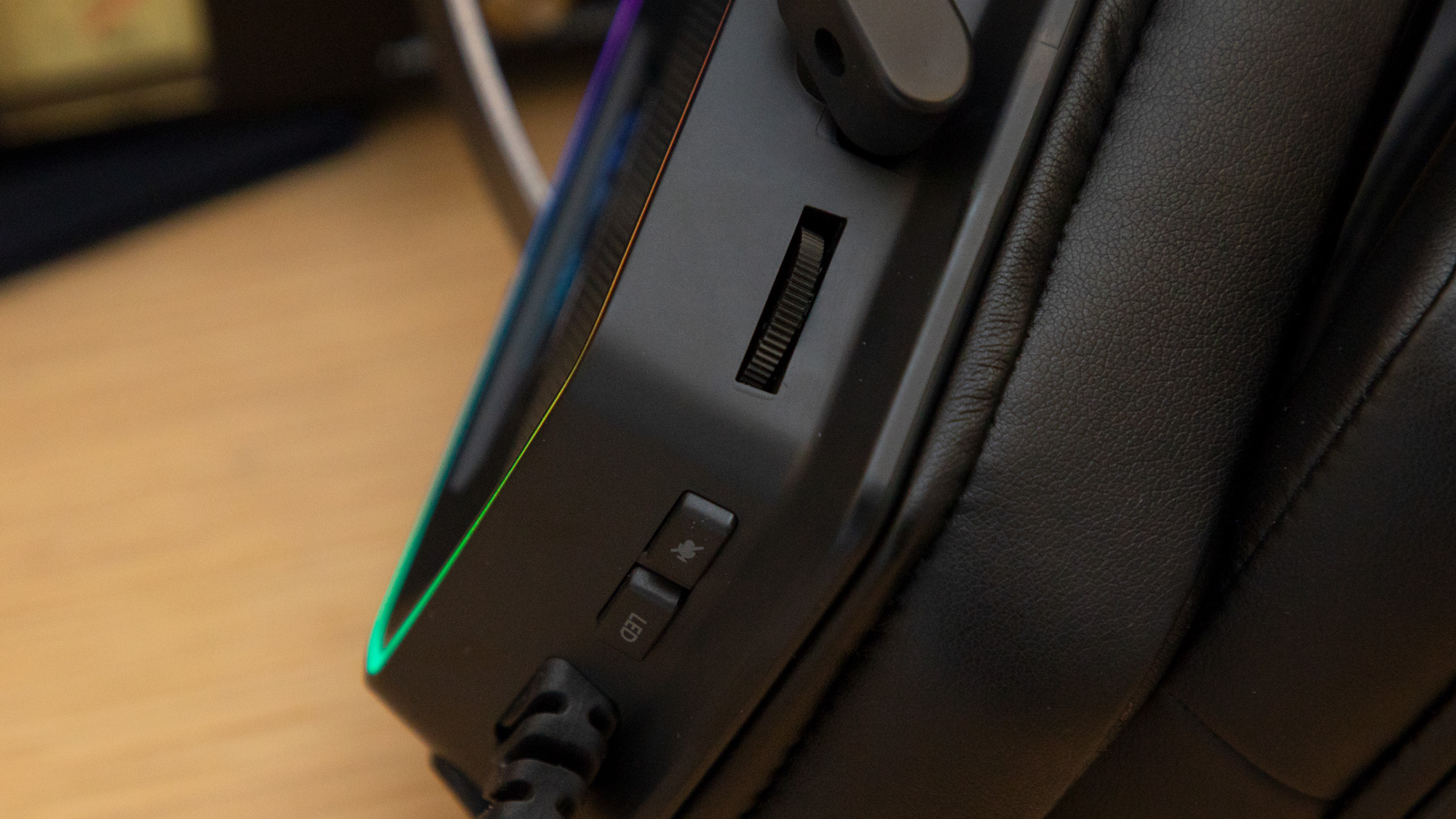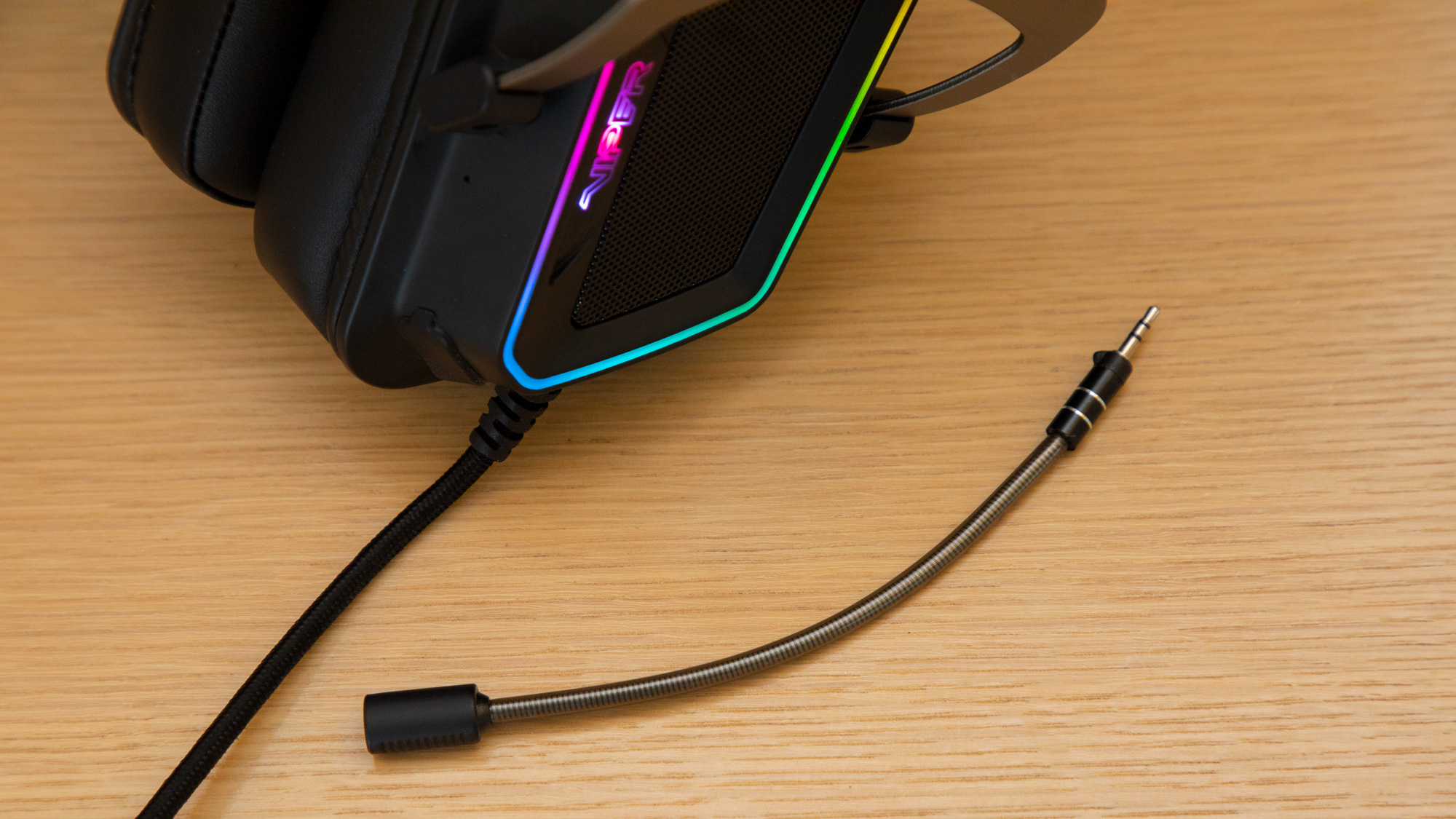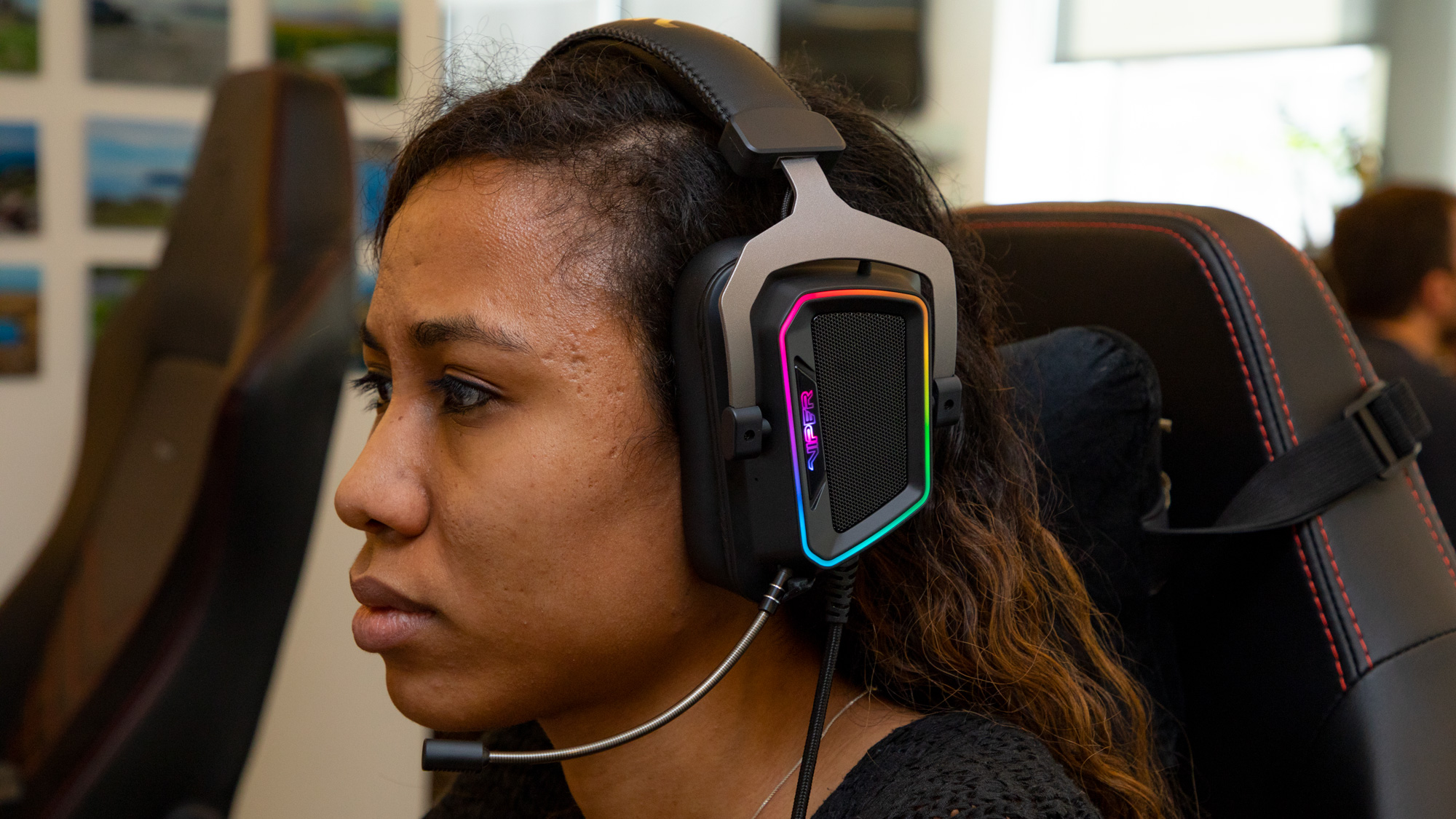Tom's Hardware Verdict
The Patriot Viper V380 provides an excellent audio experience for games, music and movies, even with sparse audio controls in its software. Its virtual surround sound sometimes proved handy for games, and its RGB lighting is admirable and easily controllable.
Pros
- +
Virtual surround sound can be helpful for games, movies
- +
Environmental noise cancellation mic produces quality sound
- +
Full-spectrum RGB LED lights on the outer ear cups
- +
Fair price
Cons
- -
Software is basic
- -
USB Type-A connection only
Why you can trust Tom's Hardware
When looking for the best gaming headset, there are a number of considerations when it comes to features. If you have the budget for it, you have the options of extras like virtual surround sound, mic noise cancellation and even, dare we say, RGB lighting. The Patriot Viper V380 offers all this at a fair price ($89.99) and represents some of the best RGB implementation we’ve seen on a pair of gaming cans yet.
With the Viper V380, you get USB Type-A connectivity with no other options and minimal software features, but the headset still produces excellent quality for all gaming and media consumption needs.
Patriot Viper V380 Specs
| Driver Type | 53mm neodymium |
|---|---|
| Impedance | 64 Ohms |
| Frequency Response | 20 Hz - 20 kHz |
| Design Style | Closed-ear design |
| Microphone Type | Omnidirectional, detachable, noise-cancelling |
| Connectivity | USB Type-A |
| Weight | 0.68 pounds (310g) |
| Cord Length | 6.9 feet (2.1m) braided cable |
| Lighting | 1 RGB zone |
| Software | Viper Software |
Design and Comfort




The Viper V380 cups have a trapezoid design that appears more angular when the RGB lighting is turned on around the perimeter. For a fun touch, the lights can be set to different colors, including red, green, blue and pink, via a button on the underside of the left cup. Users can also set the lighting to a rotating RGB spectrum and to a slow fade between colors. If that’s not enough RGB for you, the Viper logo also lights up for an extra colorful touch. Luckily, the LED control button also allows for the lighting to turn off as it may garner more than a few looks if you’re around others.
The left ear cup also features a volume control wheel and mic button on the back where your thumb would reach, while the right ear cup stays bare. Patriot went for a closed-ear design to maximize the cans’ passive noise cancellation. The soft and deep cups overall make for a comfortable fit, and adjusting the headband is simple. When drawn tightly, the band can feel heavy on the head, likely due to the metal frame that supports the ear cups. When it comes to weight, the Viper V380 is pretty average at 0.68 pounds (310g). For comparison, the HyperX Cloud Orbit S is among the heaviest at 0.8 pounds (368g), and the Asus TUF Gaming H3 is among the lightest at 0.6 pounds (294g).
Those who require a tighter fit, such as gamers with large hair or heads, may experience a bit of discomfort around the head near the top of the ears with extended wear. However, a slight adjustment of the band relieved this for me pretty safely. When pulled out loose, the headset felt a bit unstable on my head, but when I moved around it stayed steady, thanks to the deep ear cups. After getting the ideal adjustment, I had no problem wearing the Viper V380 for several hours. The padding around the ear cushions are especially comfortable and are framed by artificial (protein) leather.
Overall, the Viper V380 sports a premium build, albeit one that’s rather striking with its RGB lighting and, to a lesser degree, silver metal ear forks popping against the black headband. Still, it would be right up the alley of a gamer who favors the unusual even for everyday wear.
The attached cord is long enough that it falls well and didn’t get in the way during gameplay. The headset likely won’t be a top choice for daily multi-device audio, since your only connectivity option is USB Type-A. However, I tested the headset with a Google Pixel 4XL and USB Type-A to USB-C adapter, and it worked well. Curls and kinks are par for the course for a cord this long (6.9 feet / 2.1m), but a quick tug resolved any issues. The thick, braided design should easily withstand rough handling.
Get Tom's Hardware's best news and in-depth reviews, straight to your inbox.
Audio Performance
Gamers should have absolutely no issue with audio quality on the Viper V380. It’s slightly beefed up, with 53mm neodymium drivers, while many other top gaming headsets sport 50mm drivers. Ultimately the cans produced high-quality audio without the need for software tweaking.
The headset has multiple sources of volume control: taskbar controls, software interface and the volume wheel located on the rear of the left cup. You can adjust the volume from minimum to maximum on your computers and then increase even further on the headphones. I found setting both the computer and headset volume to absolute maximum difficult to handle.
Patriot equipped the Viper V380 with virtual 7.1 surround sound, which is also easily controlled with a simple on and off option in software. This feature can be useful with games like first-person shooters (FPS) where it’s helpful to identify the location of sound. However, The biggest difference between the 7.1 surround sound on and off when I gamed with the Viper V380 was with the clarity of the speaking voices and subtler sounds.
In the FPS game Destiny 2, activating virtual surround sound amplified more minute noises, such as the passing breeze or foes near and behind me. I didn’t find that I was able to detect incoming foes better, but once enemies were in my presence, I could clearly identify grunts and snarls from individual adversaries, particularly those headed straight toward me.
Similarly, while playing The Fallen with virtual surround sound on, I found the most pronounced sounds coming from the point-of-view aspect of the game, like the crackling fire and the sound of my character running. In this game it was easier to orient my foe’s sounds due to the up-close nature of the sword battling. The sounds of swords slicing through the air were distinct. However, the battle music overpowered much of the fight, making it difficult to focus on the much quieter action noises.

The virtual surround sound also had a pleasant effect on movies and TV. For example, when I watched Spider-Man: Into The Spider Verse, which is especially optimized for this brand of surround sound, I found that virtual 7.1 made characters’ speech clearer and more pronounced. Meanwhile, heavy beats were more balanced in comparison. In montage scenes that featured only music, the melody stood out more. I noted distinct touches, such as the music from a passing car playing on the right side while Miles and his father were driving early in the film. I was also able to point out the exact direction of various smacks, thuds, gun fires, tree rustles, and twig snaps in a number of chase scenes. Major explosion scenes felt like ASMR to the ears. With 7.1 surround sound off, speech sounded muffled and far away, while the background music became bass heavy, much like when listening to content with knowingly lower quality headphones. However, I found Spider-Man's web sling sounds were more prominent in this setting.
Not surprisingly, I found no difference between the 7.1 surround sound on or off while playing music. The sound quality was crisp and robust overall, with pronounced bass that wasn’t overbearing. I could pick up minimally produced beats if I focused hard enough.
The Viper V380 includes a detachable microphone that is malleable and easy to move around for user and listener comfort. It has Environmental Noise Cancellation (ENC), which helps block out typical noise interruptions, rather than insulating against all noise.
While video chatting with my brother, he confirmed he wasn’t able to hear the hum of my space heater, typing or the sound of cars and people outside my window with ENC. However, he did pick up the sounds of ambulances close by and music I played in the vicinity. While speaking, he found my voice loud enough to recommend I speak more softly. So it's safe to say that an excited, screaming gamer may want to position the mic a bit further away from the face.
Features and Software

The Viper V380 requires Viper Software setup for optimal use. The control interface is simple with on/off functions primarily, rather than tweakable options.
To optimize audio, users can turn the equalizer on and off or turn the Xear 3D 7.1 surround sound option on and off. The Xear Voice clarity option includes Voice Clarity Level and Noise Suppression Level features. They’re adjustable, but I typically left this off. Outside of volume controls, that’s the full extent of options for audio.
The most elaborate part of the software is the RGB control. Users can set the style of the lighting, as well as the brightness, speed, and color. The lighting supports the full RGB spectrum, allowing for a multitude of design options.
The Xear ENC option is the primary control for the mic, which also has an on/off function. The Xear Magic voice feature allows users to cloak their voice while speaking and includes dinosaur, duck, human male or human female options.
Overall, the software interface is easy to navigate. There is a prominent reset button at the bottom right corner that will take all customizations back to factory settings. There is also a setting at the top-right corner that allows users to customize the font, size and lighting of the interface itself.
Bottom Line

The Patriot Viper V380 is an excellent option for those who’d like some RGB with their cans and a comfortable fit for long-term use. The headset is fairly plug-and-play, and users likely won’t see much need to mess with the settings. The audio is quality with virtual surround sound proving a slight advantage on the battlefield. Meanwhile, the mic effectively blocks out distracting noises coming from your environment.
If the USB-only life isn’t your cup of tea, you can also check out the Asus TUF Gaming H3, which promises a good experience, great out-of-box sound quality, comfortable design and 7.1 surround sound support for half the price at $49.99. The HyperX Cloud Orbit S, while much more pricey ($250 as of this writing), also makes better use of surround sound technology and has 3.5mm, as well as Type-A and Type-C connectivity options.
Otherwise, the Viper V380 remains a relatively budget-friendly option that also brings unique RGB style.
MORE: Best Gaming Headsets
MORE: Gaming Headset Reviews